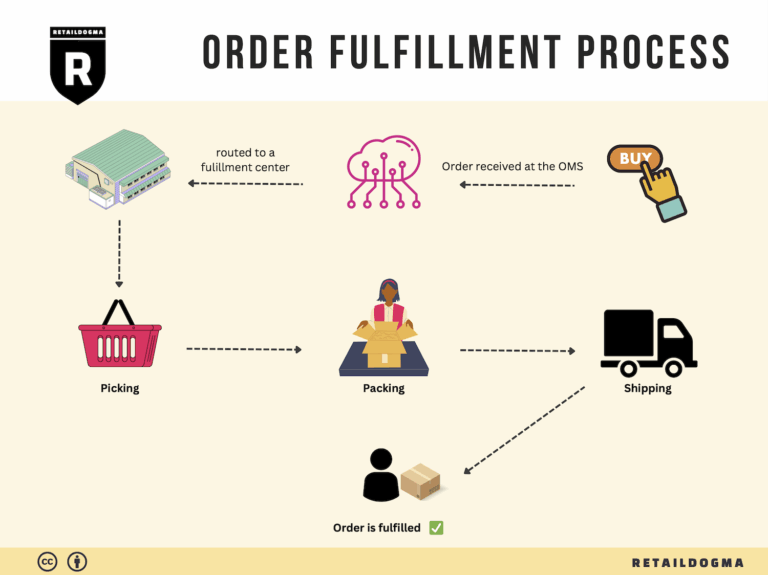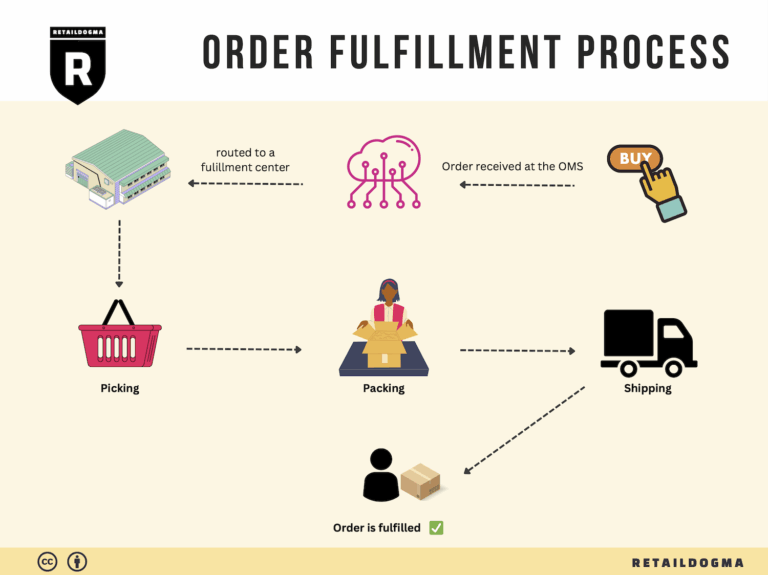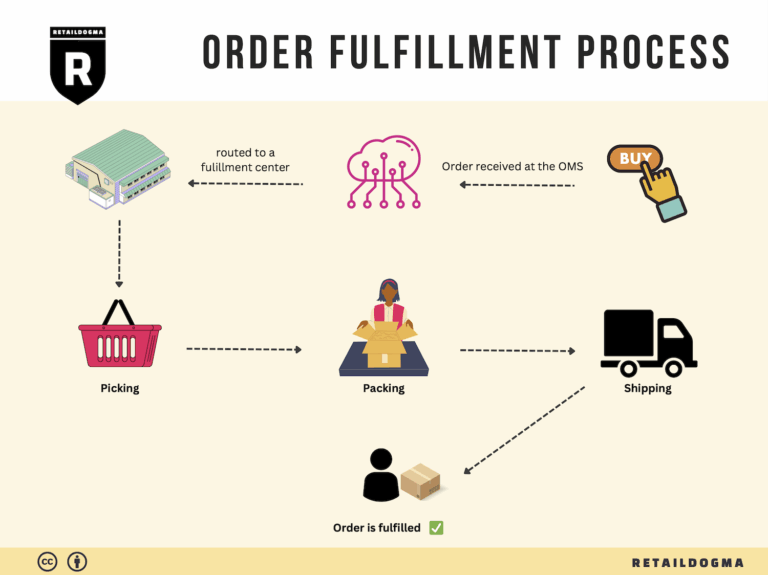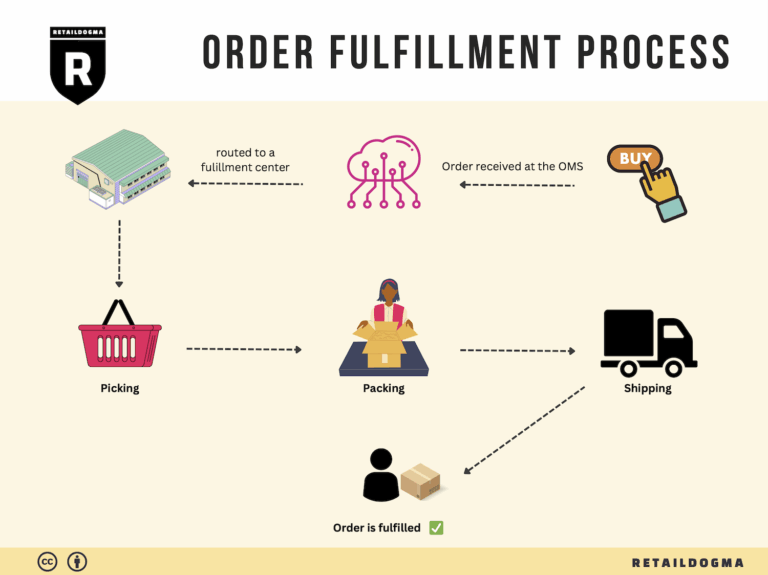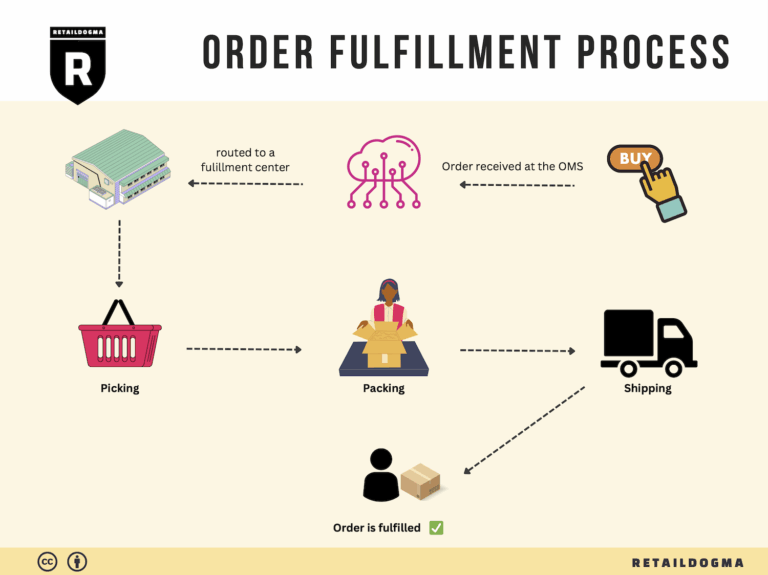Ecommerce Fulfillment Services: The Ultimate Guide (2025)
What is E-commerce Fulfillment? An Introduction for Growing Businesses
Understanding E-commerce Fulfillment: A Key to Business Growth
As e-commerce business owners, many of you may have faced a common yet daunting challenge: the overwhelming task of packing and shipping orders. Managing logistics can quickly turn into a time-consuming burden, detracting from your ability to focus on growth strategies, customer engagement, and product development. This is where effective e-commerce fulfillment comes into play.
At its core, fulfillment is the process of getting a product from your inventory to your customer’s doorstep. It encompasses everything from inventory management and order processing to packing and shipping. As your business scales, the complexity of these operations can increase significantly, prompting the need for a more structured approach.
In this guide, we will explore various fulfillment models that can help streamline your operations. You’ll learn about Third-Party Logistics (3PL) providers, which offer comprehensive logistics services, and Fulfillment by Amazon (FBA), a popular option that allows you to leverage Amazon’s vast distribution network. Understanding these models will enable you to choose the one that best fits your business needs.
We will also delve into the core services that fulfillment providers offer. These services include inventory storage, order processing, shipping, and returns management. Each of these components plays a crucial role in ensuring customer satisfaction and operational efficiency.
Choosing the right fulfillment partner is critical for your business’s success. We’ll provide practical tips on how to evaluate potential partners based on factors such as location, technology capabilities, scalability, and customer service. Pricing is another essential consideration; understanding the cost structures associated with different fulfillment services will empower you to make informed financial decisions.
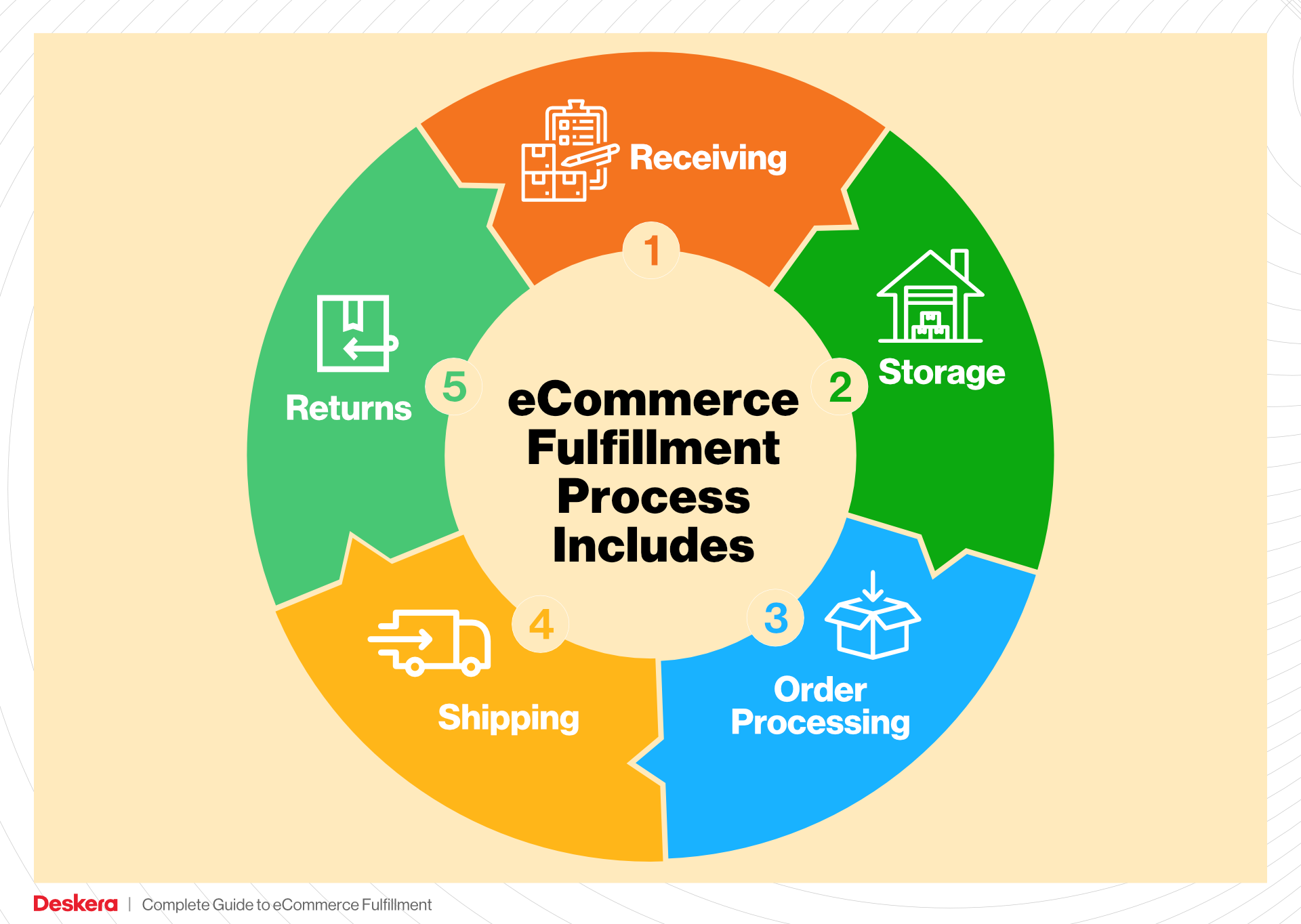
The ultimate goal of this guide is to equip you with the knowledge and tools necessary to make smart logistics decisions that support your business growth. By understanding the intricacies of e-commerce fulfillment, you can optimize your operations, enhance customer satisfaction, and position your business for long-term success in the competitive online marketplace.
What You’ll Learn In This Guide
- What is E-commerce Fulfillment? An Introduction for Growing Businesses
- The Order Fulfillment Process: From ‘Buy’ Button to Customer’s Door
- Comparing Fulfillment Models: In-House vs. 3PL vs. Dropshipping
- A Deep Dive into Amazon FBA: Pros, Cons, and Who It’s For
- Core Services Offered by Fulfillment Centers
- How to Choose a Fulfillment Partner: A 6-Point Checklist
- Understanding Fulfillment Pricing: A Breakdown of Common Fees
- Frequently Asked Questions (FAQs) about Fulfillment
- Conclusion: Is Outsourcing Fulfillment the Right Move for Your Business?
- Important Disclaimer
The Order Fulfillment Process: From ‘Buy’ Button to Customer’s Door
1. Receiving Inventory
The first step in the order fulfillment process is the receiving of inventory. When new products arrive at the fulfillment center, they are unloaded, inspected for quality, and checked against purchase orders to ensure accuracy. This process is crucial for maintaining inventory integrity and preventing stock discrepancies.
Importance: Efficient receiving operations minimize errors and ensure that the inventory levels reflected in your system are accurate. This accuracy is essential for maintaining customer satisfaction and trust, as discrepancies can lead to stockouts or delays in fulfilling orders.
Key Term: SKU (Stock Keeping Unit) – Each product is assigned a unique SKU, which aids in tracking and managing inventory throughout the fulfillment process.
2. Warehouse Storage
Once the inventory is received and verified, it is stored in designated locations within the fulfillment center. Products are organized systematically—often by category, size, or demand—to optimize space and facilitate easier access during order picking.
Importance: Proper warehouse storage increases operational efficiency. When items are stored logically and systematically, it reduces the time spent searching for products, which directly impacts the speed of the order fulfillment process.
Key Term: FIFO (First In, First Out) – This inventory management principle ensures that older stock is sold before newer stock, helping to reduce the risk of obsolescence and spoilage.
3. Order Picking
When a customer places an order, the fulfillment center generates a pick list that specifies which items need to be gathered from the warehouse. Warehouse staff then pick these items from their storage locations. The picking process can be done manually or with automated systems, depending on the scale of operations.
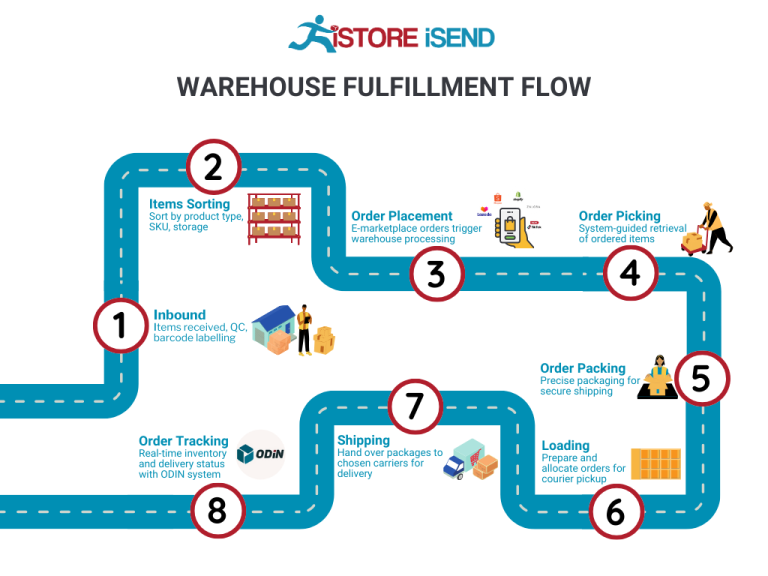
Importance: Effective order picking is critical to fulfilling customer orders accurately and swiftly. Errors during this stage can lead to incorrect shipments, resulting in customer dissatisfaction and increased return rates.
Key Term: Pick Lists – These lists are generated for each order and detail the specific SKUs and quantities that need to be retrieved, ensuring that warehouse staff can efficiently gather the correct items.
4. Order Packing
After the items have been picked, they are transported to the packing area. Here, the products are packaged securely to prevent damage during transit. Packing involves selecting appropriate packaging materials, labeling the packages, and including any necessary documentation, such as invoices or return instructions.
Importance: Proper packing safeguards products and enhances the overall customer experience. Well-packaged items reduce the likelihood of returns due to damage and convey a sense of professionalism that can enhance brand loyalty.
Key Term: Packing Slip – This document accompanies the order and lists the items included in the shipment, serving as both a receipt for the customer and a checklist for the fulfillment center.

5. Shipping & Delivery
The final step in the order fulfillment process involves shipping the packed orders to customers. This includes selecting the appropriate shipping method based on factors like cost, speed, and destination. The packages are then handed off to carriers for delivery.
Importance: Timely shipping is vital for customer satisfaction. Consumers today expect fast and reliable delivery, and any delays can negatively impact their experience and likelihood of future purchases.
Key Term: Last-Mile Delivery – This term refers to the final step of the shipping process, where the package is delivered from a transportation hub to the final destination, often representing the most significant challenge in logistics.
By understanding and optimizing each of these steps in the order fulfillment process, e-commerce business owners can enhance operational efficiency, improve customer satisfaction, and ultimately scale their logistics operations effectively.
Comparing Fulfillment Models: In-House vs. 3PL vs. Dropshipping
Fulfillment Model Comparison
| Model | Who Handles Inventory | Best For (Business Stage) | Key Advantage | Key Disadvantage |
|---|---|---|---|---|
| In-House Fulfillment | Business Owner | Startups to Established | Full control over inventory and shipping | High overhead costs and resource intensive |
| Third-Party Logistics (3PL) | Third-Party Provider | Growth Stage | Scalability and expertise in logistics | Less control over inventory and processes |
| Dropshipping | Supplier | Startups and Small Businesses | Low startup costs and no inventory risk | Lower profit margins and dependency on suppliers |
In-House Fulfillment
In-house fulfillment involves managing the entire supply chain process internally. This model requires businesses to handle their own inventory, storage, packing, and shipping. It’s often favored by startups transitioning into established companies that want to maintain complete control over their logistics operations. The primary advantage of in-house fulfillment is the ability to oversee every aspect of the fulfillment process, ensuring quality control and direct interaction with inventory. This model is particularly beneficial for brands that want to create a unique customer experience or have specialized products that require careful handling.
However, the in-house model also comes with significant downsides. It typically involves high overhead costs related to warehousing, staffing, and technology investments. Additionally, as the business scales, the complexity of operations can increase, leading to potential inefficiencies and challenges in meeting customer expectations for fast delivery. Businesses must weigh the benefits of control against the financial and operational burdens of in-house fulfillment.
Third-Party Logistics (3PL)
Third-party logistics (3PL) is a model where businesses outsource their logistics and supply chain management to specialized providers. In this arrangement, the 3PL company handles inventory storage, order fulfillment, shipping, and sometimes even customer service. This model is particularly advantageous for businesses in the growth stage that need to scale operations quickly without the overhead associated with managing logistics in-house.
The key advantage of using a 3PL provider is the scalability they offer. As sales increase, businesses can easily expand their logistics capabilities without the need for significant capital investment in infrastructure. Additionally, 3PL providers often have expertise in logistics, which can lead to more efficient processes and improved delivery times. However, the trade-off is a decrease in control over inventory and fulfillment processes, which can lead to challenges in maintaining brand standards and managing customer satisfaction. Businesses must carefully select their 3PL partner to ensure alignment with their operational goals and customer expectations.
Dropshipping
Dropshipping is a fulfillment model where retailers do not keep products in stock. Instead, when a customer places an order, the retailer purchases the item from a third-party supplier, who then ships it directly to the customer. This model is particularly popular among startups and small businesses due to its low barrier to entry and minimal upfront investment in inventory.
The primary advantage of dropshipping is the significantly reduced financial risk, as businesses do not have to invest in inventory upfront. This model allows entrepreneurs to test new products without the commitment of purchasing stock. However, dropshipping also has its drawbacks. Profit margins can be lower compared to traditional retail models, as suppliers often charge higher prices for their services. Additionally, businesses are reliant on suppliers for inventory and shipping, which can lead to potential issues with product quality, fulfillment speed, and customer service. Entrepreneurs must carefully vet their suppliers and maintain clear communication to mitigate these risks and ensure a positive customer experience.
Conclusion
Choosing the right fulfillment model is crucial for the success of an e-commerce business. Each model—whether in-house fulfillment, third-party logistics, or dropshipping—offers unique advantages and challenges. Businesses should consider their current stage, resources, and long-term goals when deciding which model best suits their operational needs. By understanding the nuances of each fulfillment option, entrepreneurs can make informed decisions that align with their business strategies and enhance their customer satisfaction.
A Deep Dive into Amazon FBA: Pros, Cons, and Who It’s For
Understanding Fulfillment by Amazon (FBA)
Fulfillment by Amazon (FBA) is a service provided by Amazon that allows sellers to store their products in Amazon’s fulfillment centers. Amazon takes care of storage, packaging, shipping, and customer service on behalf of the sellers. This enables sellers to scale their e-commerce businesses while leveraging Amazon’s extensive logistics network and customer base.
How FBA Works
-
Product Listing: Sellers create product listings on Amazon and choose to enroll their products in the FBA program.
-
Inventory Shipment: Sellers ship their products to Amazon’s fulfillment centers, such as the STL8 center in Saint Peters, MO, where products are stored until sold.
-
Order Fulfillment: When a customer places an order for an FBA product, Amazon handles the packing and shipping. Products are eligible for Amazon Prime, which offers fast, free shipping options.
-
Customer Service and Returns: Amazon also manages customer inquiries and returns, making the process seamless for sellers.
-
Fees: Sellers pay fees for storage and fulfillment services, which can vary depending on the size and weight of the products.
Pros of Using FBA
Prime Eligibility
One of the significant advantages of FBA is that products become eligible for Amazon Prime. This opens up a vast market of Prime members who prefer items with fast shipping options, thereby increasing the likelihood of sales.
Customer Trust
Products fulfilled by Amazon often carry a level of trust and credibility among customers. The assurance of reliable shipping and excellent customer service can lead to higher conversion rates and customer satisfaction.
Multi-Channel Fulfillment
FBA allows sellers to fulfill orders from other sales channels, such as their own e-commerce websites or social media platforms, using Amazon’s logistics. This multi-channel fulfillment capability provides flexibility and scalability for businesses.
Simplified Logistics
By outsourcing logistics to Amazon, sellers can focus on product development and marketing rather than worrying about warehousing, shipping, and returns. This can be particularly beneficial for small to medium-sized businesses looking to grow without the overhead costs of managing their fulfillment operations.
Cons of Using FBA
High Fees
While FBA offers many benefits, it is essential to consider the associated costs. FBA fees can add up quickly, particularly for storage and fulfillment, impacting overall profit margins. Sellers must carefully analyze these costs and factor them into their pricing strategy.
Strict Inventory Rules
Amazon has specific rules regarding inventory management, including limits on the number of units that can be stored. Sellers must adhere to these regulations, which can be challenging for businesses with fluctuating demand or seasonal products.
Commingling Risks
FBA products may be commingled, meaning that inventory from different sellers is mixed together in Amazon’s warehouses. This can pose risks, such as receiving returns for products that do not belong to the seller. It also complicates inventory management and can lead to issues with counterfeit products if not monitored closely.
Loss of Control
When utilizing FBA, sellers relinquish some control over the fulfillment process. This means they must trust Amazon to handle their products and customer service, which can be a concern for brands that prioritize a personalized customer experience.
Who is FBA Best For?
Fulfillment by Amazon is best suited for:
-
Small to Medium-Sized Businesses: Companies looking to scale quickly without investing heavily in logistics infrastructure can benefit from FBA’s streamlined processes.
-
E-commerce Startups: New businesses can leverage FBA to enter the market with lower operational costs, focusing on marketing and product development rather than logistics.
-
Brands with High Demand Products: Sellers with products that have a consistent demand can optimize their sales through FBA, as the service helps manage inventory and shipping efficiently.
-
Multi-Channel Sellers: Businesses that sell across various platforms can utilize FBA’s multi-channel fulfillment to streamline their operations and maintain consistent service levels.
-
Sellers Seeking Prime Membership: If a seller’s target market includes Amazon Prime members, FBA can significantly enhance their visibility and sales potential.
In conclusion, Fulfillment by Amazon provides a powerful solution for e-commerce sellers looking to scale their operations efficiently. By weighing the pros and cons and understanding their own business needs, sellers can determine if FBA is the right fit for their growth strategy.
Core Services Offered by Fulfillment Centers
Inventory Management & Warehousing
Inventory management and warehousing are critical components of any successful e-commerce operation. Fulfillment centers provide businesses with the space and systems necessary to store their products efficiently. This service involves tracking stock levels, managing reordering processes, and ensuring that inventory is stored in optimal conditions.
The benefits of effective inventory management are manifold. First, it minimizes the risk of stockouts and overstock situations, which can lead to lost sales or increased holding costs. Fulfillment centers often utilize sophisticated inventory management software that integrates with e-commerce platforms, allowing real-time visibility into stock levels and sales trends. This level of insight enables businesses to make informed decisions about purchasing and inventory allocation, ultimately improving cash flow and operational efficiency.
Moreover, by outsourcing warehousing to a fulfillment center, e-commerce businesses can save on overhead costs associated with maintaining their own storage facilities. This flexibility is especially advantageous for growing businesses that may face fluctuating demand, as they can scale their storage needs without the burden of long-term leases or investments in property.
Pick and Pack Services
Pick and pack services refer to the process of selecting items from inventory (picking) and preparing them for shipment (packing). Fulfillment centers streamline this process to ensure that orders are fulfilled quickly and accurately. The typical workflow involves receiving orders electronically, picking the required items from the warehouse, and then packing them according to specific guidelines to ensure safe transit.
The primary benefit of pick and pack services is the speed at which orders can be processed. In today’s e-commerce landscape, customers expect fast delivery, and fulfillment centers are equipped to meet these demands. By leveraging automation and trained staff, these centers can significantly reduce order processing times, which can lead to increased customer satisfaction and loyalty.
Additionally, fulfillment centers often implement quality control measures during the pick and pack process. This ensures that the right items are sent to the right customers, reducing the likelihood of returns due to errors. For e-commerce businesses, maintaining a high level of accuracy in order fulfillment is crucial, as it directly impacts customer experience and brand reputation.
Kitting and Assembly
Kitting and assembly services involve grouping multiple products together to create a single unit or kit, which can be particularly useful for promotional items or bundled products. Fulfillment centers can handle the assembly of these kits, which might include packaging individual items together, adding labels, or even creating customized bundles based on specific customer orders.
The benefits of kitting and assembly are significant for e-commerce businesses. First, it allows for enhanced marketing opportunities, as businesses can create attractive bundles that encourage customers to purchase more than they initially intended. This can lead to increased average order values and improved sales performance.
Furthermore, by outsourcing kitting and assembly to a fulfillment center, businesses can save time and labor costs. This is especially advantageous for small to medium-sized enterprises that may not have the manpower or resources to handle assembly in-house. By relying on the expertise of fulfillment centers, businesses can focus on their core operations, such as marketing and customer engagement, while ensuring that their products are packaged and presented in a professional manner.
Returns Management (Reverse Logistics)
Returns management, also known as reverse logistics, is the process of handling products that customers return after purchase. Fulfillment centers play a vital role in managing this complex process, which includes receiving returned items, inspecting them for damage, restocking them, or disposing of them appropriately if they cannot be resold.
The efficient management of returns is crucial for e-commerce businesses, as it directly affects customer satisfaction and retention. A streamlined returns process can enhance the customer experience, making it easy for shoppers to return items without hassle. This can build trust and encourage repeat purchases, as customers are more likely to shop with businesses that offer hassle-free return policies.
Moreover, effective returns management can provide valuable insights into product performance and customer preferences. By analyzing return data, businesses can identify trends and reasons for returns, allowing them to make informed decisions about product quality, marketing strategies, and inventory management. This proactive approach not only reduces future returns but can also lead to improved product offerings and customer satisfaction.
In summary, fulfillment centers provide a comprehensive suite of services that are essential for scaling e-commerce businesses. From inventory management to returns handling, these services enable businesses to operate more efficiently and focus on growth, ultimately enhancing customer satisfaction and loyalty.
How to Choose a Fulfillment Partner: A 6-Point Checklist
Location & Warehouse Network
Importance: The location of your fulfillment partner’s warehouses can significantly impact shipping times and costs. A partner with strategically located facilities can help you reach your customers faster and reduce shipping expenses.
Questions to Ask:
1. Where are your warehouses located?
2. How do these locations align with our primary customer base?
3. Do you have a plan for expanding your warehouse network in the future?
4. What is your average shipping time from these locations to major markets?
Technology & Integrations
Importance: Efficient fulfillment relies on advanced technology for inventory management, order processing, and tracking. A partner that offers robust technology can streamline operations and provide real-time data, which is critical for decision-making.
Questions to Ask:
1. What technology platforms do you use for order management and inventory tracking?
2. Are your systems compatible with our existing e-commerce platforms (e.g., Shopify, WooCommerce, Amazon)?
3. Can you provide real-time inventory updates and order tracking information?
4. How often do you update your technology, and what innovations are you planning to implement in the near future?
Specializations (e.g., Cold Storage, Oversized Items)
Importance: Depending on your product types, you may require specialized storage or handling capabilities. Choosing a partner with the right expertise can prevent potential issues and ensure your products are stored and shipped correctly.
Questions to Ask:
1. Do you offer specialized storage solutions (e.g., temperature-controlled or oversized items)?
2. What experience do you have with our specific product category?
3. Can you provide case studies or references from similar businesses?
4. What protocols do you have in place for handling specialized products?
Scalability & Capacity
Importance: As your business grows, your fulfillment partner should be able to scale operations accordingly. A partner that can accommodate your growth will help you maintain service levels and avoid fulfillment bottlenecks.
Questions to Ask:
1. What is your current capacity for order fulfillment, and how quickly can you scale?
2. Have you handled seasonal spikes in demand? If so, how did you manage this?
3. What are your processes for onboarding new clients or increasing capacity for existing clients?
4. How do you handle inventory management during peak seasons?
Pricing and Contracts
Importance: Understanding pricing structures and contract terms is essential for budgeting and ensuring there are no hidden fees. A transparent pricing model will help you make informed decisions and avoid unexpected costs.
Questions to Ask:
1. Can you provide a detailed breakdown of your pricing structure?
2. Are there any additional fees (e.g., storage, handling, shipping) that we should be aware of?
3. What are the terms of the contract, and are there options for flexibility or renegotiation?
4. How do you handle pricing changes in the future?
Customer Support & Reviews
Importance: A reliable customer support system is crucial for resolving issues quickly and efficiently. Additionally, reviews from other clients can provide insights into the partner’s reliability and service quality.
Questions to Ask:
1. What customer support options do you offer (e.g., phone, email, chat)?
2. How quickly can we expect a response to inquiries or issues?
3. Can you provide references or testimonials from current or past clients?
4. How do you handle disputes or service failures?
Conclusion
Choosing the right fulfillment partner is a critical decision that can significantly affect your e-commerce operations and customer satisfaction. By considering the factors outlined in this checklist, you can make an informed choice that aligns with your business goals and growth strategy. Always remember to conduct thorough due diligence and consider trial periods when possible to assess the partner’s performance before fully committing.
Understanding Fulfillment Pricing: A Breakdown of Common Fees
Initial Setup Fees
Initial setup fees are often the first costs you encounter when engaging with a fulfillment service. These fees cover the administrative work required to onboard your business into the fulfillment center’s system. This includes the creation of your account, the integration of your inventory management systems, and the setup of storage locations within the warehouse.
Typically, initial setup fees can range from a few hundred to a few thousand dollars, depending on the complexity of your needs and the fulfillment center’s pricing structure. It’s crucial to clarify what is included in these fees, as some companies may charge additional costs for specific integrations or customizations.
Receiving Fees
Receiving fees are charged when your inventory arrives at the fulfillment center. This fee covers the labor and resources involved in unloading, inspecting, and storing your products. The fee structure can vary based on the size and weight of your shipments, as well as the number of SKUs being processed.
For instance, a fulfillment center may charge a flat rate per pallet or a per-item fee for smaller shipments. Understanding how these fees are calculated can help you budget more accurately and optimize your shipping processes. To minimize receiving fees, consider consolidating shipments to reduce the frequency of deliveries.
Storage Fees (per pallet/bin)
Storage fees are recurring costs that are charged for the space your inventory occupies within the fulfillment center. These fees can be calculated on a per pallet or per bin basis, depending on how your products are stored.
Typically, storage fees are assessed monthly and can vary based on the season; for example, fees may increase during peak shopping seasons such as the holidays. Businesses should closely monitor their inventory turnover rates to avoid excess storage costs, which can accumulate quickly if products remain unsold for extended periods. Strategies such as inventory audits and clearance sales can help maintain a healthy stock level and reduce storage fees.
Pick & Pack Fees (per item/order)
Pick and pack fees are charged for the labor involved in retrieving items from storage and preparing them for shipment. This fee is typically calculated on a per-item or per-order basis.
The complexity of the order can also affect this fee; for example, orders with multiple items or special packing requirements may incur higher charges. Understanding how these fees are structured can help you streamline your order fulfillment process. Implementing efficient inventory management practices, such as organizing products by popularity or sales velocity, can help reduce pick and pack costs.
Shipping Fees
Shipping fees are the costs associated with transporting your products from the fulfillment center to the customer’s address. These fees can vary significantly based on the shipping method selected (standard, expedited, etc.), the destination, and the weight and dimensions of the package.
Many fulfillment centers offer negotiated shipping rates with carriers, which can provide substantial savings for businesses. It’s important to evaluate different shipping options and understand how the fulfillment center calculates these fees. By optimizing your packaging and consolidating shipments, you can further minimize shipping costs.
Tips for Getting an Accurate Quote
-
Provide Detailed Information: When requesting a quote, be as specific as possible about your product types, dimensions, weights, and expected order volumes. This helps fulfillment centers give you a more accurate estimate.
-
Ask About All Fees: Ensure you inquire about all potential fees, including those that may not be immediately apparent, such as seasonal storage fees or fees for special handling.
-
Consider Volume Discounts: Some fulfillment centers offer tiered pricing based on volume. If you anticipate high order volumes, negotiate for bulk discounts.
-
Review Contract Terms: Pay attention to the terms and conditions regarding fees. Some fulfillment centers may have hidden fees or clauses that could affect your overall costs.
-
Get Multiple Quotes: Don’t settle for the first quote you receive. Comparing offers from multiple fulfillment centers can help you identify the best value for your business.
By understanding these common fulfillment pricing models and taking proactive steps to manage costs, e-commerce businesses can streamline their operations and improve their bottom line.
Frequently Asked Questions (FAQs) about Fulfillment
1. What is the Amazon Fulfillment Center STL8?
The Amazon Fulfillment Center STL8, located at 5000 Premier Parkway, Saint Peters, MO, is a large-scale facility dedicated to storing, packing, and shipping a wide array of products for Amazon. It plays a vital role in Amazon’s logistics network, ensuring efficient and timely delivery of orders to customers in the region.
2. How does STL8 improve my e-commerce operations?
STL8 enhances e-commerce operations by utilizing advanced technologies and streamlined processes to manage inventory, order processing, and shipping. This allows businesses to leverage Amazon’s extensive logistics network for faster delivery times, ultimately improving customer satisfaction.
3. What is the difference between a warehouse and a fulfillment center?
A warehouse primarily focuses on storing products, while a fulfillment center is designed to handle the entire order fulfillment process, including receiving, storing, picking, packing, and shipping products directly to customers. Fulfillment centers like STL8 are optimized for fast order processing and distribution.
4. What is a Third-Party Logistics Provider (3PL)?
A Third-Party Logistics Provider (3PL) is a company that provides outsourced logistics services, including transportation, warehousing, and fulfillment. By partnering with a 3PL, businesses can focus on core operations while the 3PL manages logistics, such as those performed at STL8.
5. How much do fulfillment services cost?
Fulfillment service costs can vary based on several factors, including order volume, storage needs, and specific services required (e.g., packaging, shipping). Generally, costs include storage fees, order processing fees, and shipping charges. It is advisable to obtain quotes from multiple fulfillment centers to find the best fit for your business.
6. What products can I store at STL8?
STL8 can accommodate a wide range of products, from consumer electronics to household goods and apparel. However, certain restrictions may apply based on Amazon’s policies and regulations. It’s essential to review these guidelines when considering storage options.
7. How does STL8 handle returns?
STL8 follows Amazon’s return policy, allowing for efficient processing of returned items. Returns can be sent back to the fulfillment center, where they are inspected, restocked, or disposed of as necessary, ensuring that your inventory remains accurate and up-to-date.
8. Can I track my inventory at STL8?
Yes, Amazon provides tools and dashboards for businesses to monitor their inventory levels at STL8. This allows you to keep track of stock levels, sales velocity, and product performance, enabling better inventory management and forecasting.
9. What technology does STL8 use to streamline operations?
STL8 employs advanced technologies such as automated sorting systems, barcode scanning, and real-time inventory management software. These tools enhance operational efficiency, reduce errors, and speed up order fulfillment processes.
10. How can I get started with STL8 for my business?
To start using STL8 for your fulfillment needs, you will need to create an Amazon seller account and enroll in the Fulfillment by Amazon (FBA) program. From there, you can set up your inventory, configure your shipping plans, and integrate your online store with Amazon’s fulfillment services.
Conclusion: Is Outsourcing Fulfillment the Right Move for Your Business?
Key Benefits of Outsourcing Fulfillment
As e-commerce continues to evolve, the demands on businesses are increasing. Outsourcing fulfillment can be a transformative decision for your operations, providing significant advantages that can enhance your business’s overall efficiency and growth trajectory.
One of the most compelling benefits is time savings. By delegating the complexities of storage, packing, and shipping to a fulfillment center, you free up valuable time that can be redirected towards strategic initiatives such as marketing, product development, and customer engagement. This shift not only allows you to focus on your core competencies but also accelerates your business’s growth potential.
Scalability is another critical factor. As your sales increase, so do the logistical challenges. Fulfillment services are designed to scale with your business, accommodating seasonal spikes or long-term growth without the need for significant upfront investment in infrastructure or labor. This flexibility ensures that you can meet customer expectations for fast and reliable delivery, a crucial element in today’s competitive landscape.
Moreover, partnering with a fulfillment expert brings in-depth industry knowledge and technology that many businesses may lack in-house. This expertise can lead to optimized shipping processes, improved inventory management, and enhanced customer satisfaction, all of which contribute to a stronger bottom line.
Choosing the Right Partner
However, it’s imperative to choose the right fulfillment partner. The right fit should align with your business goals, offer transparent pricing, and demonstrate a proven track record of reliability and customer service. As you evaluate potential partners, consider their technology capabilities, geographic reach, and responsiveness to your specific needs.
Call to Action
Now is the time to assess your current shipping and fulfillment processes. Conduct an audit to identify pain points and evaluate whether outsourcing fulfillment could be your next strategic move. Embrace the opportunity to streamline your operations and position your business for sustained growth in the ever-evolving e-commerce landscape.
Important Disclaimer
⚠️ Important Disclaimer
The information in this guide is for educational purposes. Fulfillment services, pricing, and platform features change frequently. Always conduct your own due diligence and consult with providers directly before making business decisions.

